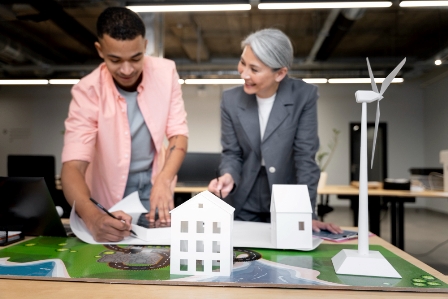In the quest for a more sustainable future, the construction industry has emerged as a key player in adopting environmentally friendly practices. Sustainable construction, often referred to as green building, encompasses a range of strategies and technologies aimed at minimizing the environmental impact of building projects. Let’s delve into the innovations driving the shift towards sustainable construction and how they are shaping a greener future for the built environment.
Key Principles of Sustainable Construction
Energy Efficiency
One of the fundamental principles of sustainable construction is the emphasis on energy efficiency. Buildings are designed to optimize energy consumption, incorporating features such as smart lighting, efficient insulation, and the use of renewable energy sources.
Use of Eco-Friendly Materials
Green building practices prioritize the use of environmentally friendly materials, such as recycled steel, bamboo, and reclaimed wood. This not only reduces the demand for new resources but also minimizes the carbon footprint of construction projects.
Water Conservation
Sustainable construction integrates water-saving technologies, including low-flow plumbing fixtures and innovative rainwater harvesting systems. These measures contribute to water conservation, a crucial aspect of environmentally responsible building.
Waste Reduction
Efforts to minimize construction waste are integral to sustainable practices. Recycling and reusing materials, as well as employing construction methods that generate less waste, are key components of sustainable construction projects.
Innovative Technologies in Sustainable Construction
Green Roofs
Green roofs, covered with vegetation, provide insulation and reduce the heat island effect in urban areas. They also contribute to biodiversity and stormwater management, showcasing a harmonious integration of nature into construction.
Solar Panels and Renewable Energy
The widespread adoption of solar panels and other renewable energy sources has revolutionized the construction industry. Buildings can now generate their own energy, reducing reliance on traditional power grids and lowering their environmental impact.
Smart Building Systems
The incorporation of smart technologies allows buildings to optimize energy usage, lighting, and temperature control. Smart building systems enhance the efficiency and sustainability of structures, adapting to environmental conditions and occupant needs.
3D Printing in Construction
Innovative construction methods, such as 3D printing, offer a sustainable alternative by minimizing material waste and speeding up the construction process. This technology has the potential to revolutionize the industry, making construction faster, more cost-effective, and eco-friendly.
Challenges and Solutions in Sustainable Construction
High Initial Costs
While the long-term benefits of sustainable construction are evident, the initial costs can be a deterrent for some stakeholders. However, innovative financing models and incentives are being explored to make green building more economically viable.
Limited Awareness
A lack of awareness about the benefits and techniques of sustainable construction remains a challenge. Educational campaigns and industry outreach are crucial in bridging this knowledge gap and fostering a widespread understanding of green building practices.
Regulatory Hurdles
Navigating complex regulations and building codes can pose challenges for sustainable construction projects. Advocacy for updated and streamlined regulations that support green building is essential for widespread adoption.
Integration of Sustainable Practices in Traditional Construction
Integrating sustainable practices into traditional construction methods requires a shift in mindset and skill sets. Training programs and industry collaboration play a vital role in ensuring that sustainable construction becomes the norm rather than the exception.
Benefits of Sustainable Construction
Environmental Impact
Sustainable construction significantly reduces the environmental impact of building projects, from energy consumption to material use. This contributes to mitigating climate change and preserving natural resources for future generations.
Economic Advantages
While the upfront costs may be higher, sustainable construction offers long-term economic benefits. Energy savings, reduced maintenance costs, and increased property values make green buildings economically attractive in the long run.
Improved Occupant Health and Well-being
Green buildings prioritize indoor air quality, natural light, and overall occupant well-being. Studies show that occupants of sustainable buildings experience improved health and productivity, emphasizing the holistic benefits of green construction.
Future Trends in Sustainable Construction
Advancements in Green Technologies
Ongoing advancements in green technologies, such as energy-efficient HVAC systems and smart building materials, will continue to shape the future of sustainable construction. Staying abreast of these innovations is crucial for industry professionals and stakeholders.
Integration of Artificial Intelligence
The integration of artificial intelligence (AI) in construction processes enhances efficiency, reduces waste, and optimizes resource use. AI-driven solutions have the potential to revolutionize how sustainable construction is approached and implemented.
Global Collaboration for Sustainable Building Standards
As sustainability becomes a global priority, collaboration on building standards and best practices is essential. International cooperation ensures that sustainable construction is a shared goal, transcending geographical boundaries for a collective impact.
Role of Government and Policies in Promoting Sustainability
Incentives for Green Building Practices
Governments play a pivotal role in promoting sustainable construction through incentives, subsidies, and tax breaks for green building initiatives. Examining successful government policies provides insights into effective strategies for fostering sustainability.
Legislation Supporting Sustainable Construction
Enacting and enforcing legislation that supports sustainable construction practices is crucial for widespread adoption. Governments worldwide are increasingly recognizing the importance of regulatory frameworks that prioritize environmental responsibility.
Educational Initiatives: Shaping the Future of Sustainable Construction
Importance of Training and Awareness
Educational initiatives are key to shaping the future of sustainable construction. Training programs that equip professionals with the skills needed for green building and awareness campaigns targeting the general public contribute to a sustainable construction ecosystem.
Collaboration between Academia and Industry
Collaboration between academia and the construction industry is vital for ensuring that education aligns with industry needs. Establishing partnerships that bridge the gap between theoretical knowledge and practical application strengthens the foundation of sustainable construction practices.
International Perspectives on Sustainable Construction
Varied Approaches Worldwide
Different regions adopt unique approaches to sustainable construction based on local conditions, resources, and cultural considerations. Examining international perspectives provides a comprehensive understanding of the diverse strategies employed globally.
Cross-Cultural Exchange of Sustainable Practices
Cross-cultural exchange of sustainable construction practices facilitates a mutual learning process. Sharing success stories and challenges among nations fosters a collaborative environment for advancing sustainable construction on a global scale.
Community Engagement in Sustainable Construction
Social Responsibility in Building Projects
Sustainable construction goes beyond technical aspects; it involves a sense of social responsibility. Engaging with local communities, understanding their needs, and incorporating their input into construction projects contribute to holistic sustainability.
Community Benefits of Green Construction
Communities benefit from green construction through improved air quality, enhanced green spaces, and job creation. Analyzing the positive impact of sustainable construction on communities underscores the broader societal advantages of environmentally responsible building.
Measuring Success: Metrics in Sustainable Construction
LEED Certification and Other Standards
Measuring the success of sustainable construction projects involves adherence to standards like LEED certification. These benchmarks provide a tangible way to assess the environmental impact and overall sustainability of a building.
Long-Term Impact Assessment
Beyond immediate metrics, assessing the long-term impact of sustainable construction is crucial. Understanding how buildings perform over time in terms of energy efficiency, durability, and environmental impact informs future practices and innovations.
Adoption Challenges in Developing Countries
Economic Constraints
Developing countries face unique challenges in adopting sustainable construction practices, primarily due to economic constraints. Exploring strategies to overcome these challenges and make green building more accessible in such contexts is essential.
Lack of Infrastructure
Lack of infrastructure poses a significant hurdle in the adoption of sustainable construction in developing nations. Innovative solutions and international collaborations can help address these challenges and pave the way for sustainable development.
Balancing Aesthetics and Sustainability
Architectural Innovations
Balancing aesthetics with sustainability is a key consideration in green construction. Architectural innovations, such as eco-friendly designs and sustainable materials, showcase how aesthetics and environmental responsibility can coexist.
Integration of Sustainable Features in Design
Integrating sustainable features into the design process ensures that aesthetics and functionality align with environmental goals. Examining successful projects that strike a balance between aesthetics and sustainability provides valuable insights for the industry.
FAQs
Individuals can contribute by adopting energy-efficient practices at home, supporting green initiatives, and advocating for sustainable construction in local development projects.
Yes, several developing countries have implemented successful sustainable construction projects, showcasing innovative approaches to overcome economic constraints and lack of infrastructure.
Technology, such as smart building systems and 3D printing, plays a significant role in optimizing resource use, reducing waste, and enhancing the overall efficiency of sustainable construction practices.
Governments incentivize sustainable construction through subsidies, tax breaks, and other financial incentives to encourage builders and developers to adopt green building practices.
Yes, despite higher initial costs, sustainable construction proves cost-effective in the long run due to energy savings, reduced maintenance costs, and increased property values.
Conclusion
Innovations in sustainable construction are shaping a greener future for the built environment. From energy-efficient technologies to community engagement, the journey towards sustainability involves a multifaceted approach. As the construction industry continues to evolve, embracing and advancing sustainable practices will be crucial for a more resilient and environmentally conscious future.


